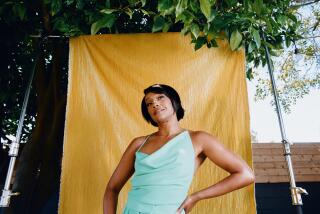For Imaginations Without Walls
The painting, 75 feet long by 10 feet tall, fills an entire wall along the therapy pool at Eisenhower Medical Center in Palm Desert. Tall in the background in the picture are the Santa Rosa mountains at dusk, looking like crushed gold velvet. Then come the smaller foothills, black and more jagged. In the foreground is the desert with dozens of palm trees and flowers and a lake.
In the painted sky are hot-air balloons as brightly colored as jelly beans, duplicates of the balloons that float above the valley every day in the winter season. And at the top of the mural, a bright rainbow makes a semicircle of color.
The bright and beautiful mural is the work of John Feight of Atlanta, who has paintings in facilities in 80 countries and who has helped hundreds of handicapped and ill people to paint, too.
Feight has a sense of whimsy, which shows in one balloon that carries the word Hope, and in tiny letters across the basket the name Dolores. The therapy pool is in the Dolores Hope building; she is the chairman of the board of the Eisenhower Medical Center.
John Feight is a self-taught artist who was in advertising. He was doing a commissioned painting at a hospital when a little girl, a burn victim, came up to him and said: “I want to paint too.”
“My first impulse was to say: ‘I’m busy. Please go away,’ ” Feight says. “But how do you tell a little girl with her face almost gone and three fingers destroyed by the burns that she can’t paint?
“I fixed a brush to her bandaged hand and showed her where she could help me with the background. That’s when I decided that my hospital paintings were ending in the wrong places--in the lobby or in executives’ offices.
“From then on, I decided that I would make windows of walls. People who are sick and suffering should see the outside, not blank walls.”
That’s when Feight formed the Foundation of Hospital Art. He is a 50-ish man with a warm smile. He has painted in hospitals all over the world, and most important, he believes, had the patients help with the painting. He is a soft-spoken man who is able to involve the patients, families, employees, physicians and friends in the creation of beauty.
“We want our hospitals to be the most beautiful places to get well in. We do not want people to suffer in cold, hard places,” he says.
Feight was 26 when he started his hospital painting. Peggy Koerner of Palm Desert became acquainted with Feight in New York and introduced him to the Memorial Sloan-Kettering Cancer Center there.
At Sloan-Kettering, there was a long windowless corridor leading into the radiology room. Feight painted Italiante arches looking out over a gentle ocean and added delicate branches leaning across the edges of the arches. The whole thing was backed by a blue sky.
It was Koerner who commissioned the mural and the paintings at the Eisenhower Center as a memorial for her late husband, Irving Koerner.
Hospital officials choose the scene they would like. Then Feight sketches the outline of his painting and color-codes each section so that his hospitalized painters can choose the right acrylic colors.
Besides large-scale scenes, Feight designs squares with pictures of flowers and butterflies that fit together to make larger pictures. A little boy in a hospital in Lexington, Ky., worked on a square that ended up as part of a picture of a bunch of flowers that hangs on the wall of the Children’s Cancer Hospital in Moscow.
Feight has painted sunlight through pine trees for one room with a blank wall--the scene that was really outside the room. He likes to paint the walls behind forbidding large machines necessary in some therapies, explaining he wants the patients see something colorful and happy rather than the intimidating equipment.
He has painted at the Princess Grace Hospital in Monaco and in London and Paris.
He will go now to Singapore, Brunei, Hong Kong and the Middle East. And he’ll paint with Olympic athletes in Barcelona in 1992 as he did in Seoul at the last Olympics.
At the end of our conversation in Palm Desert, he added: “There is an army of men and women waiting to paint in convalescent and retirement homes.”
The Foundation of Hospital Art is funded by hospital auxiliaries, corporate sponsors, individuals, churches and schools, civic organizations and foundations.
More to Read
The biggest entertainment stories
Get our big stories about Hollywood, film, television, music, arts, culture and more right in your inbox as soon as they publish.
You may occasionally receive promotional content from the Los Angeles Times.






